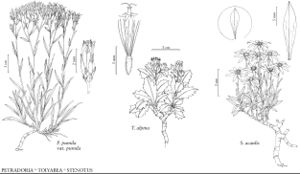Difference between revisions of "Petradoria pumila var. pumila"
Treatment appears in FNA Volume 20. Treatment on page 172.
FNA>Volume Importer |
FNA>Volume Importer |
||
| Line 42: | Line 42: | ||
|publication year= | |publication year= | ||
|special status= | |special status= | ||
| − | |source xml=https://jpend@bitbucket.org/aafc-mbb/fna-data-curation.git/src/ | + | |source xml=https://jpend@bitbucket.org/aafc-mbb/fna-data-curation.git/src/f6b125a955440c0872999024f038d74684f65921/coarse_grained_fna_xml/V19-20-21/V20_376.xml |
|tribe=Asteraceae tribe Astereae | |tribe=Asteraceae tribe Astereae | ||
|genus=Petradoria | |genus=Petradoria | ||
Revision as of 18:42, 24 September 2019
Stems 0.8–3 cm. Leaf blades usually 3–5-nerved, broadly linear to oblanceolate, rarely lanceolate, 30–120 × 2–12 mm. Heads 25+. Involucres 6–9.5 × 1.9–3 mm. Phyllaries 10–21. Ray florets (1–)2–3; corollas 4.5–9 mm, laminae 1–2.4 mm wide. Disc florets 2–4; corollas 4.5–6.2 mm, lobes 0.8–1.3 mm. 2n = 18, 36.
Phenology: Flowering summer–fall.
Habitat: Dry, open, rocky places
Elevation: 1000–3100 m
Distribution

Ariz., Calif., Colo., Idaho, Nev., N.Mex., Utah, Wyo.
Discussion
Selected References
None.
Lower Taxa
None.
